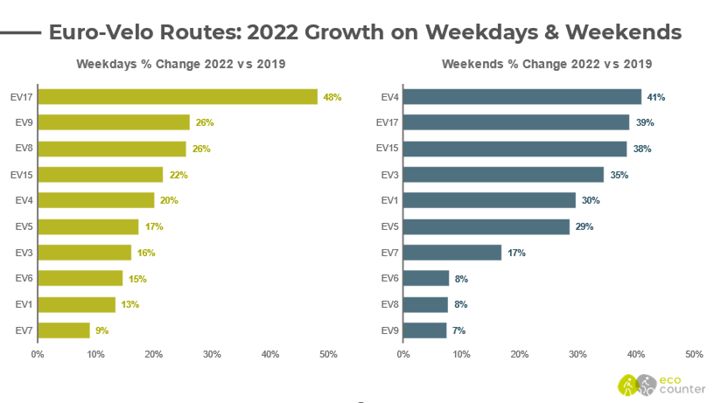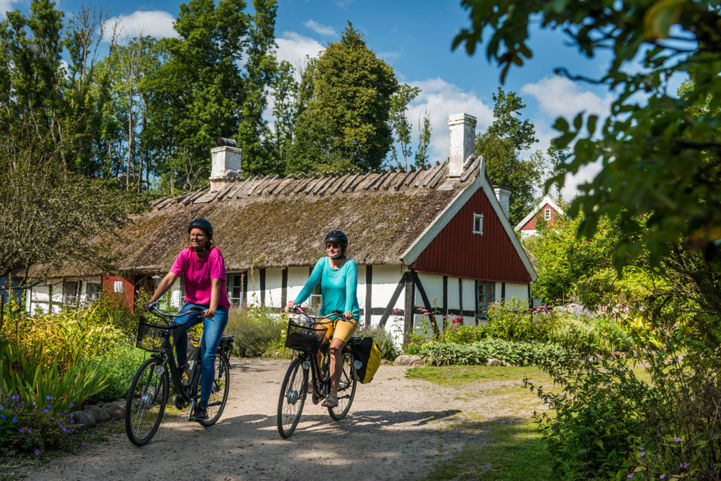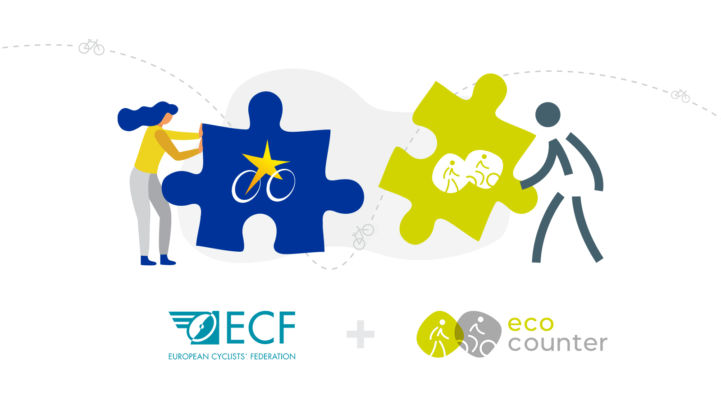The ‘new normal’ features a lot more cycling! Trips on the EuroVelo network increase sharply in 2022
Confirming a trend that had been observed already during the first quarter, the new figures, which Eco-Counter presented at the Velo-city conference in Ljubljana, show increases in usage between 10% (EuroVelo 7) and 45% (EuroVelo 17) for the year 2022 so far, compared to 2019. What is more, growth has been consistently high both on weekdays and on weekends. This is different to 2020 and 2021, when overall growth was mainly sustained by higher cycling levels on weekends. This could mean that while increases in recreational cycling have continued since the start of the pandemic, utilitarian cycling is now also at a considerably higher overall level than before the outbreak of COVID-19, as restrictions have been lifted and people take up new commuting habits to their workplaces for example.

For the first time, and with the kind permission of Eco-Counter’s local partners, the analysis also included samples from individual counting sites where infrastructure had recently been developed, pointing to a link between route development and usage levels:

- Salernes on EuroVelo 8 - Mediterranean Route, east of Aix-en-Provence, has seen usage figures increase by 14% in 2020, 47% in 2021, and a staggering 91% during the first five months of 2022 (all compared to 2019). According to the regional authorities, this was also thanks to “the rise of EuroVelo 8 as a major support facility for cycling” in the area.
- Coulée d’Oc on EuroVelo 3 - Pilgrims Route, north of Bordeaux, witnessed increases of 31% in 2020, 80% in 2021, and 79% in 2022 so far, again compared to 2019. A representative from the managing regional authority stated that the “paved site, separated from traffic,… provided an ideal cycling route during the lifting of lockdown measures.”
- Rorum in Sweden, on EuroVelo 10 - the Baltic Sea Cycle Route recorded substantial increases of 31% in 2020, 27% in 2021 and 14% in 2022 so far compared to 2019. The explanation given by a representative of Sweden’s Scania Region was that “Sweden’s third national bicycle route opened in the summer of 2019, Sydkustleden. That route was the “missing link” between Sydostleden and Kattegattleden.”
- Hakamaa in Finland, on a commuting route connecting suburbs of Oulo that also forms part of EuroVelo 10, featured increases in cycling levels of 24% in 2020, 16% in 2021, and 23% in 2022 compared to 2019. According to the city of Oulo, the construction of a cycle superhighway has played an important role here.

Information about data collection
This publication on the usage of the EuroVelo network is based on a partnership between ECF and Eco-Counter. The two organisations have joined forces to work together closely in collecting, analysing and communicating data related to the EuroVelo network at the European level. The aggregated results for the usage of the EuroVelo network in 2022 so far are based on data from a sample of 170 automatic counters installed by Eco-Counter and its local partners. For the sample, we have selected counters where we found that there was a minimum level of representativity, both in number of counters and in number of countries along the route represented. This is currently the case for EuroVelo routes 1, 3, 4, 5, 6, 7, 8, 9, 15 and 17. We publish data on the usage of the network as a whole, and on featured routes, regularly. In the future, we hope to be able to grow this sample and make it even more representative, as more counters are placed along the routes all around Europe.